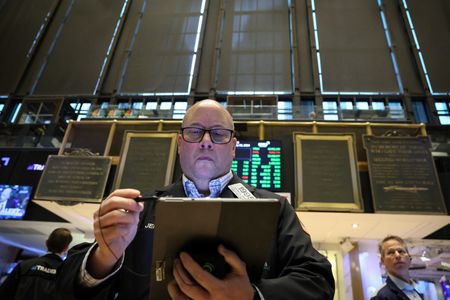(Reuters) – US stocks reversed course to rise on Tuesday afternoon while investors kept an eye on higher Treasury yields and continued to evaluate earnings to assess the health of American companies.
“The bargain hunting resumed,” said Steve Sosnick, head trader at IBKR Securities Services. On Monday, the Dow Jones Industrial Average and the S&P 500 closed lower, retreating from six straight weekly gains.
At 02:26 p.m. the Dow Jones Industrial Average rose 54.67 points, or 0.13%, to 42,986.27, the S&P 500 gained 1.39 points, or 0.02%, to 5,855.37 and the Nasdaq Composite gained 44.42 points, or 0.24%, to 18,583.92.
Almost half of the S&P sectors were in the positive territory, with the consumer staple leading the pack up 0.83%. The industrials index was down 0.96%.
The change in markets direction came after the benchmark 10-year note yields earlier reached 4.222%, the highest since July 26, as investors reassessed expectations for the Federal Reserve’s policy trajectory. But yields dialed back to 4.1957%.
“The big story overall is the rates back up and the concerns that the Federal Reserve made a policy error by moving too aggressively in September. That’s feeding through to a rate sell off on a global basis,” said Michael Green, portfolio manager at Simplify Asset Management.
On the corporate front, GE Aerospace slumped 8.52% despite raising its profit forecast for 2024, as persistent supply constraints impacted its revenue. It pulled the broader Industrials index 0.96% lower.
Some rate-sensitive megacap stocks slipped, with Apple falling 0.52% and Nvidia down 0.19%, but overall the broader technology sector was up 0.19%.
Microsoft jumped 2.47%.
“During the earnings season, you often get this kind of choppiness, but there’s also increased uncertainty relative to the interest rate direction,” said Chuck Carlson, CEO at Horizon Investment Services.
The next few weeks are likely to be volatile for equity markets, as investors scrutinize company earnings, fresh economic data and results of the U.S. election, followed by a central bank meeting.
Traders are pricing in a 91% chance of a 25-basis-point interest-rate cut in November, according to CME’s FedWatch.
Among other earnings, Verizon lost 4.9% as the telecom giant missed estimates for third-quarter revenue.
3M slipped 1%, reversing its premarket gains, despite raising the low end of its full-year adjusted profit forecast.
Meanwhile, General Motors leapt 10.06% after the legacy carmaker’s third-quarter results beat Wall Street estimates, while Lockheed Martin dipped 6.56% after results.
Rate-sensitive homebuilding stocks slipped, with the PHLX Housing index dropping 2.49%, dragged down by a 5.86% fall in shares of PulteGroup despite the company beating profit and revenue estimates.
“The earnings themselves have been pretty good, it’s just the companies highly sensitive to interest rates are probably going to find a bit of headwind right now as investors sort out the whole interest rate story,” Carlson said.
Baker Hughes and Texas Instruments are scheduled to report earnings after the bell.
Declining issues outnumbered advancers by a 1.53-to-1 ratio on the NYSE. There were 140 new highs and 54 new lows on the NYSE.
The S&P 500 posted 11 new 52-week highs and 4 new lows while the Nasdaq Composite recorded 61 new highs and 53 new lows.
(This story has been refiled to fix a typo in paragraph 4)
(Reporting by Lisa Mattackal and Purvi Agarwal in Bengaluru; Editing by Pooja Desai, Shounak Dasgupta, Maju Samuel and Aurora Ellis)



